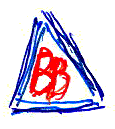Chapter 2 - Wave Theory and
Photons
Printer-Friendly Version
In 1669, a Dutch physician, Erasmus Bartholinus (1625-1698),
discovered that a  crystal
of Iceland spar, a transparent form of calcium carbonate,
produces a double image (picture right). Apparently, light
passing through the crystal splits into two rays. This simple
observation indicates that light has two components and is
part of the basis of wave theory. Together with other observations,
it stressed that light can appear in two forms. crystal
of Iceland spar, a transparent form of calcium carbonate,
produces a double image (picture right). Apparently, light
passing through the crystal splits into two rays. This simple
observation indicates that light has two components and is
part of the basis of wave theory. Together with other observations,
it stressed that light can appear in two forms.
In 1808, a French army engineer, Étienne Louis Malus
(1775 -1812), discovered polarized light.

Some optically active systems rotate the plane of polarized
light in a clockwise direction. This is taken as a right-handed
turn; such systems are dextrorotatory. Others turn light in
a counter-clockwise direction and are levorotatory. In later
observations, it was seen that some plastic devices polarize
light waves in a transverse position, while others polarize
light waves perpendicular to one to other. In whole light,
those two forms always appear together and it is easy to split
them into two rays (picture below).

Thus we see that one part of a photon moves in a perpendicular
plane and the second seems to be in a transverse position
(picture, below right). The structure of  the
photon resembles astronomical observations, whereby a transverse
cloud of energetic matter connects vertical discs. the
photon resembles astronomical observations, whereby a transverse
cloud of energetic matter connects vertical discs.
In the picture above, we see that the loop in the perpendicular
position is well defined and shining. The loop in the transverse
position is composed of active energetic matter; wider than
the first loop, it is cloud-like, not clearly visible and
with no clear borders. As the loops are in perpendicular and
transverse positions and belong to the same star couple formation,
perhaps, the photon also has the same structure (picture below).

Back to
Top
Dr. Chaim Tejman, Copyright©
2001. All rights reserved.
[]
[Introduction]
[Summary] [Wave
Formation] [Photons] [Gravitation]
[Time]
[Atoms] [Life]
[Cancer] [Fundamental
Force] [Gender/Why Sex?]
[Sexual Reproduction]
[Schrodinger & Heisenberg]
[Creation] [Supernova]
[Dark
Matter & Astronomy] [Speed
of Light] [Cloud Formations]
[Natural Disasters] [Global
Warming] [Thermodynamics]
[Backward Time] [Quantum
Mechanics] [Compton Effect]
[Equations] [Predictions]
[Academic Correspondences] [Contact]
[Links] [Mysteries] |